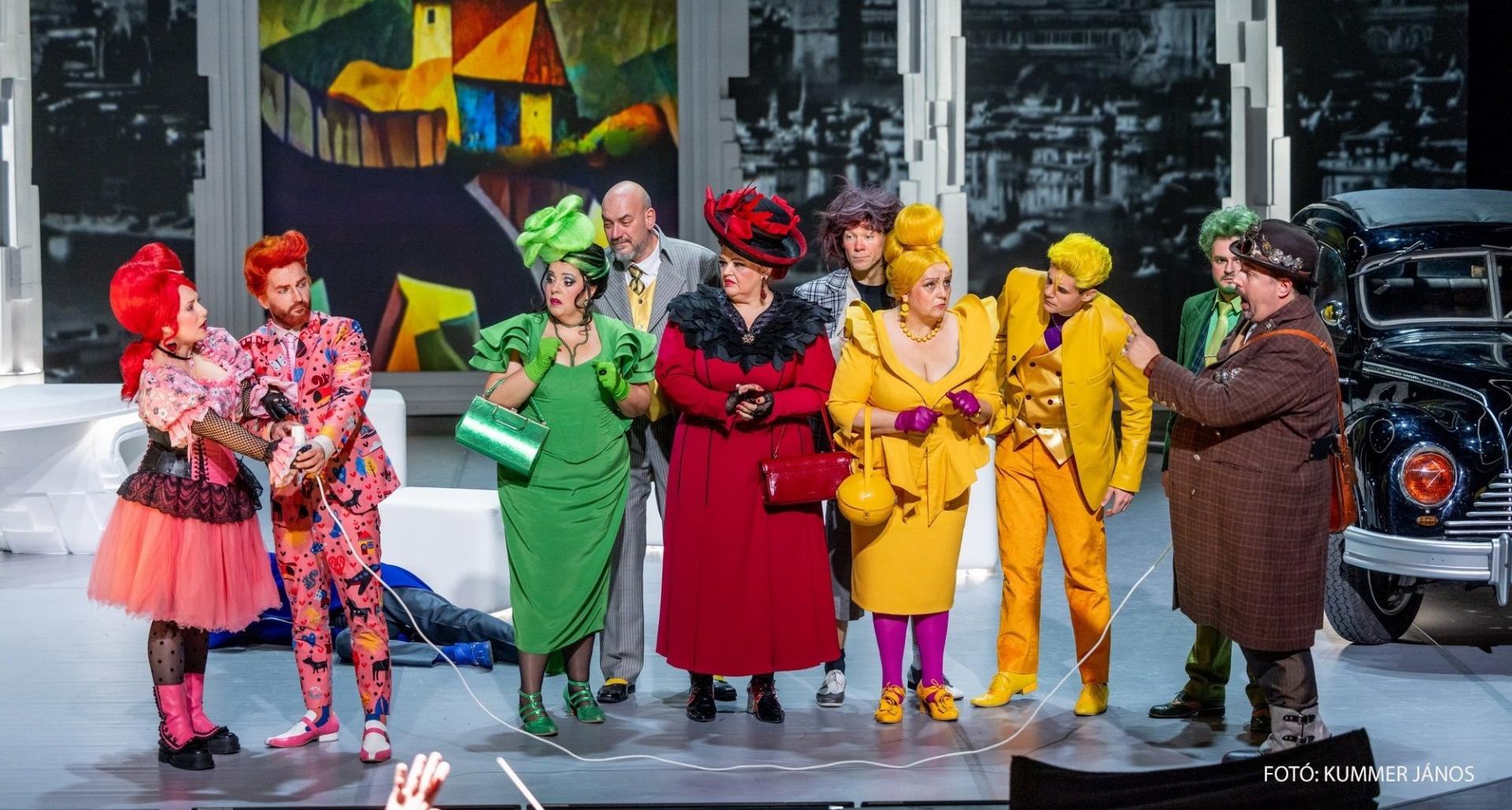Schicchi 2.0
October 2025 | ||||||
|---|---|---|---|---|---|---|
Mo | Tu | We | Th | Fr | Sa | Su |
Schicchi 2.0 – Giacomo Puccini
Comic opera | Contemporary
Running time: 1 hour without intervals
Language: Italian
Surtitles: Hungarian, English, Italian
We can safely say that Gianni Schicchi is one of the most entertaining comic works of opera literature, which stands out even in the opera oeuvre of Giacomo Puccini with its wittiness. Ingenious moments chase one another both in the vocal and orchestral parts, and also through the text and the incredibly funny situations. Not many works dare to apply the black, nay morbid humour that allows the comical family intrigues enfold right next to the deathbed of a relative.
Age restriction: The performance is not recommended for children under 12 years of age.
Synopsis
The body of the recently deceased wealthy nobleman Buoso Donati lies on the deathbed surrounded by relatives there to angle for his inheritance. They have good reason to worry, and not just because they are a big family: there are rumours going around a northern village, Signa, that Buoso has left his entire estate to a monastery. They turn over the entire house in search of his will. The document is found at last by the young Rinuccio, who makes his Aunt Zita promise him that if there is enough money for the family, he can marry his love, Lauretta. As it turns out, the gossip is true: Buoso Donati has left all of his money to the monks. Rinuccio counsels the despairing relations to seek the help of Lauretta's father, Gianni Schicchi, the low-born man who has nevertheless prospered from his own wits. Schicchi arrives with his daughter. Meeting, however, with arrogance, disdain and antipathy from the noble family, he is about to depart when his daughter speaks directly to his heart: she will die if she can't marry Rinuccio! Schicchi agrees to the game to please Laura. Suddenly Doctor Spinelloccio knocks on the door: he is there to examine the extremely ill Donati. Imitating the deceased Buoso, Schicchi assures the doctor that he is better now. Schicchi sends the relatives to summon the notary, and then wearing Donati's clothes proceeds to dictate his final will and testament. The relatives each try to bribe Schicchi to favour them over the other relatives when it comes to the best of the inheritance: the mule, the Donati residence in Florence, and the mill in Signa and Schicchi nods at each of them, reminding them separately that they must forever remain silent about the ruse, or they'll be punished by the law for fraud. The notary arrives with two witnesses, and Schicchi dictates his will, but to everyone's mute astonishment, leaves the mule, Donati's house, and the mill to himself, Gianni Schicchi! The family rages, but they cannot say a word lest the deception be discovered. When the notary departs, they furiously steal what they can, but Schicchi ejects them from the house and looks touched at the happy couple, Rinuccio and Lauretta.
Program and cast
Conductor: Dániel Erdélyi, Sámuel Csaba Tóth
Gianni Schicchi - Csaba Szegedi
Lauretta - Laura Topolánszky, Anija Lombard (opera studio), Zsuzsanna Kapi
Zita - Erika Gál
Rinuccio - Gergely Boncsér, Barna Bartos
Gherardo - Tibor Szappanos, Péter Balczó
Nella - Lilla Horti, Natália Tuznik
betto di Signa - István Rácz, Bence Pataki
Simone - László Szvétek, Géza Gábor
Marco - Tamás Koczka, Attila Dobák
La Ciesca - Lusine Sahakyan, Mária Farkasréti
Amantio di Nicolao, a notary - Attila Erdős, Boldizsár Zajkás
Amantio di Nicolao, a notary - Zoltán Bátki Fazekas
Pinellino, a shoe designer - Dávid Dani
Guccio, a fashion designer - Artúr Szeleczki
Gherardino - N. N.
Featuring the Hungarian State Opera Orchestra
Director: Attila Toronykőy
Set designer: Balázs Fügedi
Costume designer: Katalin Juhász
Lighting designer: Tamás Pillinger
Video designer: Zsombor Czeglédi
Musical director: Kálmán Szennai
Hungarian State Opera
STANDING ROOM TICKETS - INFORMATION IN CASE OF A FULL HOUSE!
If all the seats are sold out for the selected time, but you still want to see the production on that day, 84 of the extremely affordable standing seats will be sold at the theatre, 2 hours before the start of the performance, with which you can visit the gallery on the 3rd floor. Tickets can be purchased at the ticket office of the Budapest Opera House. We would like to draw your attention to the fact that the stage can only be seen to a limited extent from the standing places and the side seats, but at the same time, following the performance is also supported by television broadcasting on the spot.
The Opera House is not only one of the most significant art relic of Budapest, but the symbol of the Hungarian operatic tradition of more than three hundred years as well. The long-awaited moment in Hungarian opera life arrived on September 27, 1884, when, in the presence of Franz Joseph I. the Opera House was opened amid great pomp and ceremony. The event, however, erupted into a small scandal - the curious crowd broke into the entrance hall and overran the security guards in order to catch a glimpse of the splendid Palace on Sugar út. Designed by Mikós Ybl, a major figure of 19th century Hungarian architecture, the construction lived up to the highest expectations. Ornamentation included paintings and sculptures by leading figures of Hungarian art of the time: Károly Lotz, Bertalan Székely, Mór Than and Alajos Stróbl. The great bronze chandelier from Mainz and the stage machinery moda by the Asphaleia company of Vienna were both considered as cutting-edge technology at that time.
Many important artists were guests here including Gustav Mahler, the composer who was director in Budapest from 1887 to 1891. He founded the international prestige of the institution, performing Wagner operas as well as Magcagni’ Cavalleria Rusticana. The Hungarian State Opera has always maintained high professional standards, inviting international stars like Renée Fleming, Cecilia Bartoli, Monserrat Caballé, Placido Domingo, Luciano Pavarotti, José Cura, Thomas Hampson and Juan Diego Flórez to perform on its stage. The Hungarian cast include outstanding and renowed artists like Éva Marton, Ilona Tokody, Andrea Rost, Dénes Gulyás, Attila Fekete and Gábor Bretz.

 EN
EN DE
DE IT
IT FR
FR ES
ES RU
RU JP
JP RO
RO
 Seating plan
Seating plan 